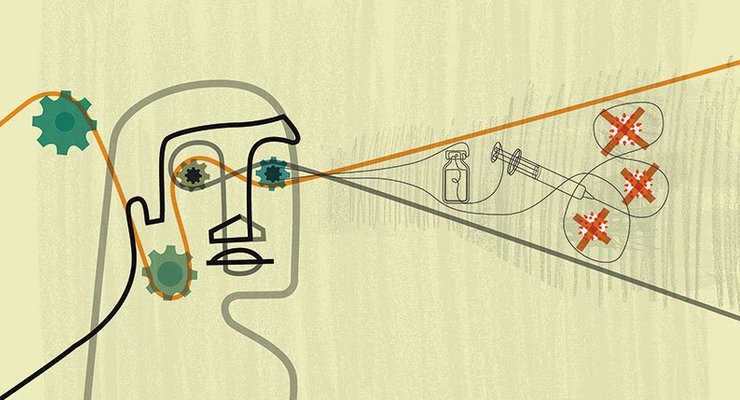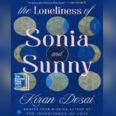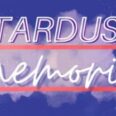
When aerosol expert Richard Flagan could not come to campus to investigate the effectiveness of masks at stopping transmission of the SARS-CoV-2 virus, he brought the work home with him: specifically, to his home garage and its collection of woodworking tools.
That is just one of the many ways Caltech researchers had to adjust not only the work being performed in their labs, but also the manner in which that work took place after in-person operations nearly ground to a halt in early 2020. Since then, many more intrepid scientists, engineers, and students have sought to refocus their work to address the needs of the global health crisis, despite hardships like limited capacity rules, shortages in resources, and fear of an unknown and evolving virus.
Nearly two and a half years later, these scientists have made crucial contributions to both local and national efforts to control the spread of the SARS-CoV-2 virus. These life-saving advances were made possible thanks to new funding, more public health data, a greater understanding of the virus and its effects on society, and the desire of students to help. Here are some of the major developments that have taken place in labs across campus, the unique challenges they presented, and the rewards they delivered.
Safeguarding the Workplace
Flagan, an engineer and expert in aerosol processes, flew to Helsinki in February 2020 to participate in a workshop about atmospheric particle formation experiments at the European Organization for Nuclear Research (CERN).
“I was very nervous to travel,” Flagan says. “I had been aware of COVID since the first press reports, and the descriptions sounded like an airborne disease transmission, but that was not the message that was being delivered.”
By the time he returned to campus, Caltech was just days away from shutting down nearly all research. Exceptions were being made, however, for studies involving COVID-19. Initially, Flagan’s laboratory was involved in a study of how the first major lockdowns affected air quality. Soon, concern arose about how to open laboratories again. “The variability of mask effectiveness became one of the central questions,” Flagan says.
Flush with state-of-the-art aerosol instruments in his laboratory, he realized that testing masks was a great match for his research group. There was just one problem: as a person over the age of 60, Flagan was up against the strong recommendation to avoid coming onto campus, even for critical projects.
Enter Buddhi Pushpawela, a postdoctoral researcher who had joined Flagan’s team in November 2019. Alone in the lab, she set to work in June 2020 to build an experimental apparatus using whatever parts she could find, scouring campus for masks to test how effective they were at blocking the virus. But first, she needed to figure out how to seal the masks to the sampling instruments. In his home workshop, Flagan cut custom wood frames that Pushpawela used to clamp the masks to the plates. “Whenever I had issues, I showed the setup to Professor the modifications,” says Pushpawela, now a clinical assistant professor of physics and astronomy at the University of Alabama in Huntsville. “I have the theoretical background and the subject knowledge, but I used some of the instruments for the first time for the face-mask testing project.”
During the experiments, she measured particle penetration, breathing difficulty, and performance at different oxygen flow rates. It was a process that took nearly two hours to complete for each mask, but Pushpawela managed to test more than 400 samples, including N95s, KN95s, surgical masks, and cloth masks. Based on those results, Flagan and Pushpawela made recommendations that guided Caltech’s initial purchase of masks to help reopen campus widely for the 2021 fall semester. In addition, Flagan conducted webinars, presentations, and discussions on social media to inform the public about the effectiveness of various masks. The team published a paper with their findings in the journal Aerosol Science and Technology in December 2021. “I believe we made a contribution to stopping the spread of COVID-19 and saving lives from COVID-19, at least among the Caltech community,” Pushpawela says.
A Universal Vaccine?
Structural biologist Pamela Björkman is no stranger to viruses. She has dedicated her career to investigating the body’s immune response to viral pathogens, and she had already received supplemental National Institutes of Health (NIH) funding to study the emerging SARS-CoV-2 virus by February 2020. But even with many similar studies under her belt, this undertaking felt different. “Everybody knew that it was going to be very bad,” Björkman says. “And running a lab was very confusing back then. We had density rules, we had to have shifts, and we had to constantly figure out who could work where and space people far apart. I was very worried that we would have an outbreak in the lab. We didn’t, but I remember being very nervous about that.”
Despite these stressors, the Björkman group has made significant progress in its goal to develop a universal vaccine against current and future coronaviruses.
First, Christopher Barnes, then a postdoctoral scholar in Björkman’s lab and now an assistant professor of biology at Stanford, detailed the structures of antibodies produced by the body to fight COVID-19 and discovered how those antibodies bind to the virus’s spike proteins (the parts that invade host cells) to stop the infection process. Barnes found that the antibodies attach to a part of the virus called the receptor-binding domain, or RBD. But not all the antibodies were binding at the same place on the RBD and the RBDs varied between the original SARS-CoV-2 virus and its newly emerging variants, as well as between related coronaviruses found in animals.
And so, Björkman says, “we did something we’ve been trying to do for HIV and other viruses in my lab for a long time. We made a nanoparticle that’s a mosaic, meaning it co-displays different versions of the antibody target on the virus.”
Alex Cohen (PhD ’21), now a postdoctoral scholar in the Björkman group, designed a mosaic nanoparticle to present eight different RBDs on 60 attachment sites.
Testing of the concept in animal models as a vaccine showed that the nanoparticle evokes strong immune response to not only the viruses included in the vaccine, but also to additional coronaviruses not included in the vaccine. Further testing has revealed the mosaic nanoparticle approach prompts antibodies to target harder-to-reach but more-conserved elements of the virus RBD, as opposed to the parts that may change with a new variant or type of coronavirus. This means the vaccine should provide broad protection regardless of how the virus mutates in the future or if new coronaviruses spill over from animals into humans, making it a strong candidate for a potent universal vaccine. The Björkman group has received funding from the Coalition for Epidemic Preparedness Initiative to conduct Phase 1 human clinical trials.
“This vaccine candidate can be used as a booster, since most people are already vaccinated or have been infected with SARS-CoV-2,” Björkman explains. “It would be more protective, I believe, against possible future emerging viruses, and you wouldn’t need to change it as we are confronted with more SARS-CoV-2 variants of concern.”
Modeling Transmission
As the pandemic raged on and classes remained virtual, many students wanted to get involved in COVID-19 research. Yaser Abu-Mostafa (PhD ’83), an expert in machine learning, decided to give students in his spring 2020 computer science class a project. The result was a model to predict the spread of the virus that consistently beat out estimates made by the Centers for Disease Control and Prevention (CDC).
“We switched the entire research and teaching effort to focus on forecasting the spread of COVID-19 in the United States,” says Abu-Mostafa, who had been working on a fundamental theoretical question in deep learning prior to the pandemic. “The students are the ones who took the initiative, and I went for it based on my assessment of the value of artificial intelligence technology to help with what was clearly a national emergency.”
The CDC model used data from 45 major models at universities and institutes across the country, but it did not emphasize artificial intelligence (AI), which has the power to discover patterns hidden in data that humans might miss. Early tests of Caltech’s AI-driven CS156 model, named for the class where it began as a competition, showed it was more accurate than the CDC model nearly 60 percent of the time. Though it proved extremely valuable, Abu-Mostafa says it was not easy to accomplish.
“We needed to steer the whole ship in a completely new direction in short order,” he explains. “This involved organizing the biggest team I have ever supervised, setting up the computational and data infrastructure, securing the funding, and, most importantly, formulating the scientific vision and the strategy to implement it successfully.” It started with a class of more than 150 students producing 40 viable models for predicting the spread of COVID-19. From there, the top 10 models were aggregated, and a research team that included a core group of students from the class took the findings forward to create a model with an expanded scope, making rapid and precise predictions about mortality rates, numbers of infections, and test positivity rates.
“In the early days of the pandemic there were massive data gaps and uncertainties in everything from case levels to rates of mask wearing,” says graduate student Dominic Yurk (BS ’17, MS ’21), who was the lead teaching assistant for the course and continued as a member of the research team when the class ended. “Figuring out how to make valuable predictions from highly uncertain data was a new and valuable research experience.”
Shortly after initial results of the model were made public in summer 2020, the California Department of Public Health asked for access to the team’s daily prediction files, which informed the department’s decision-making as it managed the pandemic.
“We expected to do well given our expertise in AI, but beating all the national models put together was a surprise,” Abu-Mostafa says. “While I am used to taking scientific risks, this experience encouraged me to take organizational and funding risks that are against my nature, when the opportunity arises.” The COVID-19 model also inspired him to look at other medical problems that machine learning might help solve. “It was my first experience in research that can, and likely did, save lives,” Abu-Mostafa says. “I haven’t done that before in my career, and the experience made me more energized in my current focus on medical applications of AI.”
Measuring Viral Load
Viruses need hosts to replicate, but exactly when a person is contagious is not always easy to pinpoint, especially with a new pathogen.
“The world clearly didn’t have information on how to detect SARS-CoV-2 early, before people transmit the infection,” recalls chemical engineer Rustem F. Ismagilov about the early months of the pandemic. “It was not known how much virus there was and, therefore, what sort of test would be good enough to detect it, and in which sample types, like saliva or nasal mucus, the virus was.” With the interdisciplinary team of researchers that makes up his lab, which is committed to improving global health, Ismagilov set out to answer those questions. The lab partnered with the Pasadena Public Health Department (PPHD) to launch a large community-based study to investigate how viral load changes in different sample types over time after someone has been infected. Here’s how it worked: contact tracers from local public health departments, clinics, and testing sites, including Caltech’s Student Wellness Services, shared study details with people recently infected with SARS-CoV-2 and their uninfected housemates. The 410 participants who enrolled self-collected their samples once or twice a day for about two weeks and sent the samples to the lab to be analyzed with a high-sensitivity research assay. The Ismagilov lab team then calculated viral load in each sample type (saliva, nasal swabs, and throat swabs) to see where the virus accumulated first and figure out how sensitive a diagnostic test would need to be to detect the virus in that sample.
Although they are still analyzing data, Ismagilov’s team has released three preprints online and a publication in the Journal of Clinical Microbiology that outline several important findings thus far: the virus generally appears first in oral samples, which suggests that many early infections are not being detected by nasal-swab tests; viral load is highly variable among sample types, suggesting that there is no single best COVID-19 test type and better testing strategies are needed; and taking COVID-19 tests first thing in the morning helps improve test sensitivity significantly, suggesting a simple change that can make tests more reliable. Ismagilov says performing a large study like this amid the pandemic added challenges to every aspect, from getting the study organized, designed, and launched, to running the study and securing the necessary and often scarce lab reagents.
“It would have been easier to do nothing, but the team felt very strongly they had to make this contribution,” Ismagilov says.
The Ismagilov lab’s COVID-19 study is already having a ripple effect on the group’s future work. To make the COVID-19 study a reality, the group built a new infrastructure for conducting longitudinal community-based studies, says Natasha Shelby, scientific research manager for the Ismagilov lab and study administrator for the COVID-19 study.
“That infrastructure will open so many doors to study health conditions that have been challenging to understand,” she says, adding that the group has plans to publish their study-design templates to help other labs launch similar studies and get critical data right when a new pathogen emerges.
“We answered the questions we set out to answer,” Ismagilov says. “I witnessed incredible dedication and self-sacrifice, not only from our lab but from many other members of the Caltech community, including volunteers who made the study possible.”
Sensing Infection
Having had experience building biosensors to monitor disease and health-related parameters like glucose, it made sense for medical engineer Wei Gao to apply his expertise to COVID-19.
“We wanted to figure out what we could do to help our community find cases of COVID-19,” Gao says. “We realized that a rapid test was very important. At that time [in early 2020], there were limited resources for testing and, even if you got a test, it took several days to get the results.”
With funding from Caltech’s Merkin Institute for Translational Research—which provided seed funding for nearly 20 projects across a number of Caltech laboratories and research groups in April and May of 2020—Gao and members of his lab quickly began to develop a low-cost, portable, and ultrafast COVID-19 testing platform.
By fall 2020, he and his team had created a new type of multiplexed test, meaning it tested for not only active infection of SARS-CoV-2 but also infection severity and immunity. Gao’s version combines multiple data sets for a more-precise diagnosis. Building on previous successes with sensors made of graphene, a sheet-like form of carbon, Gao used the same material to build a sensor that could detect a COVID-19 infection through rapid analyses of small volumes of saliva or blood, without the involvement of a medical professional, in less than 10 minutes.
Gao then teamed up with Harry Rossiter, an investigator at the Lundquist Institute for Biomedical Innovation at the Harbor-UCLA Medical Center, to test the sensor using blood and saliva samples from COVID-19-positive and COVID-19-negative study participants. Dubbed the SARS-CoV-2 RapidPlex, the testing platform contains antibodies and proteins that could help identify the presence of the virus in the sample, determine whether the sample contains antibodies that indicate a prior infection, and assess the severity of a current infection.
“It really worked well,” Gao says. “We were surprised at how efficiently we can collect all this data simultaneously.”
While the RapidPlex platform wasn’t fully tested in time to be competitive in the marketplace, it earned Gao a National Science Foundation CAREER Award in April 2022 to adapt the sensor to monitor long COVID.
“We are looking at developing a wearable device to continuously monitor different types of long-COVID biomarkers or risk factors in our daily activities to help us better understand the long-term effects of COVID-19, and maybe give people early warning of long COVID complications as well,” Gao says.



















